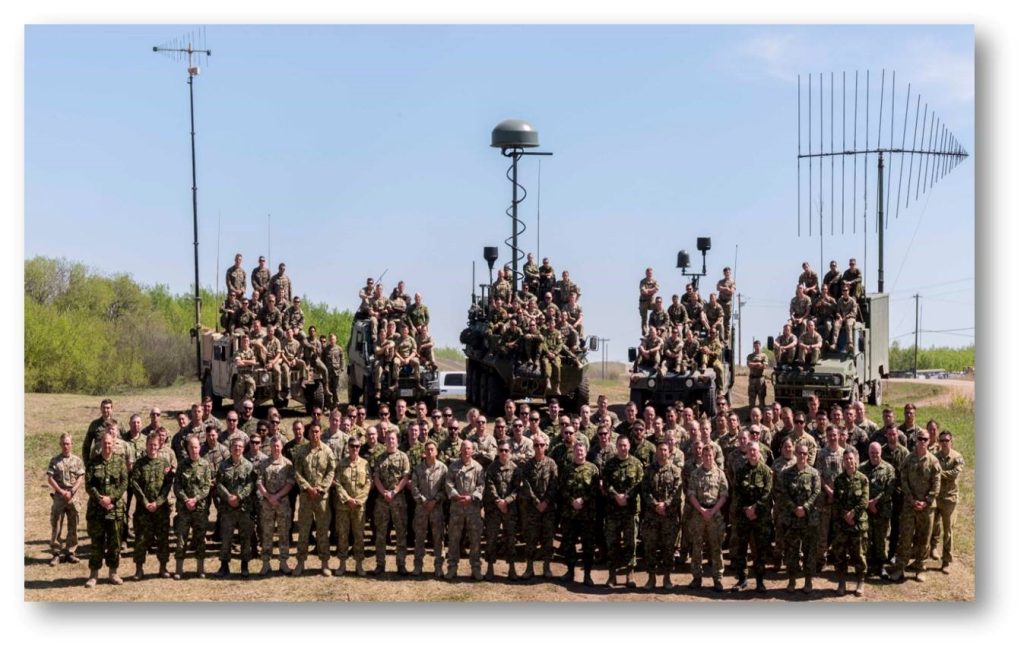by Ian Coutts
In the world of electromagnetic warfare, what you can’t see can definitely hurt you. Wherever we are in the world today – this includes our own homes as well as in the modern battlespace – we are immersed in a bath of electromagnetic radiation. From the perspective of electromagnetic warfare, that includes everything from microwaves to low frequency radio waves. Radios, wi-fi systems, satellite navigation tools, even modern watches, all emit signals – and those signals can be discovered, tracked, disrupted, and blocked by an adversary.
Making sure what we can’t see in the electromagnetic warfare sphere can’t hurt us – and using the same electromagnetic warfare tools to help us – is the job of the 21 Electronic Warfare Regiment.
Founded in 2010, but with a pedigree that stretches back right to the Special Wireless, or Y units, of the First and Second World Wars, most people, in the military and outside of it, don’t know much about the Kingston-based unit. That may be in part because electronic warfare (EW) is a slippery concept to grasp. It may also be because what they are dealing with is, at the end of the day, something most of us are not normally aware of. And it may be that given the nature of their work, they deliberately maintain a low profile.
But not too low, as Captain Eric Brisebois, the regiment’s training officer, admits. “If they [combat arms] don’t know what we do, how can they use us?”
That’s part of the reason why he has agreed to speak with me this day in late September, in the secure buildings they work from in a corner of CFB Kingston.
Simply put, the regiment has three roles: Electronic attack, electronic protection, and electronic support. Attack is essentially doing unto others in the electromagnetic sphere. Protection is stopping them from doing unto you. Electronic support, says Brisebois, “is our bread and butter. That entails “collecting information which has strategic or tactical value.” Information understood in terms of the electro-magnetic spectrum, where the nature of the signal can tell a trained operator as much as the content of the message sent. “If there is a platoon hiding in the woods, and if we can pick up their signal, it could tell me where they are and their possible intent” – even if they can’t read the transmission content, Brisebois explains by way of example.
These days the regiment is kept particularly busy in Latvia as part of a NATO multinational battle group. Brisebois has just returned from a six-month tour, where he was serving as an Electronic Warfare Liaison Officer (EWLO) between the Canadian-led enhanced Forward Presence Battle Group, Canadian Joint Operations Command, and 21 EW Regiment.
The unit’s presence in Latvia is an acknowledgment of the direction Russian military thinking has taken in recent years. “Russia has had a roadmap since 2008 that they want electronic warfare to be a part of their combat teams,” Brisebois explains, “and they have pushed a lot of money in there. Russia has acknowledged EW and its potential as a force multiplier.”
To combat that, even theoretically, requires the same capability. A key part of the regiment’s work in Latvia has been education – for NATO allies, other elements within Canadian Armed Forces, and even other units of the Canadian Army.
“We’re a small unit,” he says, “and we can’t always travel to Edmonton or Petawawa or Valcartier and work with units there.” The time in Latvia has been a great chance to work alongside different units from across the country. “This might be the first time a particular group has had EW units” working with them and teaching them the language of EW so that they can work better together.

Latvia will occupy the regiment’s efforts for the foreseeable future. Having a troop deployed with another preparing to go puts a lot of strain on a relatively small unit of just two Regular EW squadrons and, unique in the Canadian Army, an embedded Reserve squadron that provides individual augmentees. At the time we spoke, they were getting ready to send out another troop, the fourth in recent years to serve on Op Reassurance.
In the future, too, they’ll be playing an important role in the new combat support teams (CSTs) that the 6 Canadian Combat Support Brigade (CCSB) began trialing in 2018. These will consist of elements drawn from CCSB’s constituent units – Canadian Army Intelligence Regiment, 4th Artillery Regiment (General Support), 4 Engineer Support Regiment, Influence Activities Task Force, and 21 EW – whose disparate skills and equipment are combined to create what Brisebois terms a “fused ‘sense’ function” to supplement a Canadian Mechanized Brigade Group. It is a more effective way to make use of capabilities the Army has but has not always exploited to the fullest.
“As part of the team, we could have an Electronic Warfare Coordination Centre, which could range from an officer or some other individual as a liaison officer. Or it could be a bigger element, depending on what’s required. And then that element would write the orders for the troops and provide the tasks,” he says. The CSTs would not be permanent formations but could be “task tailored” when needed.
The Army has already experimented with the CST concept on Exercise Maple Resolve and at other major training events to see how it works in practice. During the time that he was in Latvia, Brisebois talked up the CST across “the battle group, the division and the corps.” Once the Army approves the concept, the next step will be to formalize CSTs, which will allow more of the Army to take advantage of 21 EW’s skills and technology. In the meanwhile, the regiment will be doing its best to get the word out about EW. “If we don’t educate and promote our capabilities, they will not be able to employ us or be interested in us joining them,” says Brisebois.

